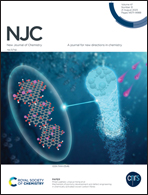Highly efficient post-synthetically modified UiO-66 MOF for the extraction of Pd(ii) from aqueous solutions: experimental and theoretical studies†
Abstract
Recovery of palladium from high level liquid waste is necessary to meet increasing demands of industries and safe management of radioactive nuclear waste. Efficient extraction of palladium is a challenging task and the growing field of metal organic frameworks with tunable functionality offers some viable options in this direction. Herein, we present the synthesis of two newly functionalized MOFs, namely, UiO-66-dithizone and UiO-66-phenylenediamine, from UiO-66-NH2via post-synthetic modification (PSM). These zirconium-based MOFs were employed for the removal of Pd(II) from aqueous medium. The Zr(IV)-carboxylate bonds, present in these MOFs, impart great stability to the material while the nitrogen and sulphur-based soft functional groups provide sites for efficient binding of palladium. Different characterization techniques were employed for the characterization of the functionalized MOFs. The sorption behavior studies of Pd(II) with the PSM MOFs, UiO-66-dithizone, UiO-66-phenylenediamine and the parent MOF UiO-66-NH2 as a function of pH, revealed that the UiO-66-dithizone MOF showed the highest sorption tendency at pH 5 with a value of 280 mg g−1 followed by UiO-66-phenylenediamine with a value of 272 mg g−1 compared to the parent MOF, which displayed a maximum sorption capacity of 96 mg g−1. Thus, the reported PSM strategy showed excellent improvement in the sorption behavior of the parent MOF towards palladium. The origin of the superior extraction abilities of the PSM MOFs was further probed by extended X-ray absorption fine structure (EXAFS) studies on palladium-sorbed samples, which shows a functionalized moiety of the MOFs binding to palladium. Additionally, density functional theory (DFT) calculations were also performed to gain insight into the nature of interactions operating between Pd(II) and the MOFs. The mechanism of sorption was explored by X-ray absorption studies and density functional theoretical calculations and it was found that UiO-66-dithizone and UiO-66-phenylenediamine bind Pd(II) through C![[double bond, length as m-dash]](https://www.rsc.org/images/entities/char_e001.gif) S and NH2 groups.
S and NH2 groups.



 Please wait while we load your content...
Please wait while we load your content...